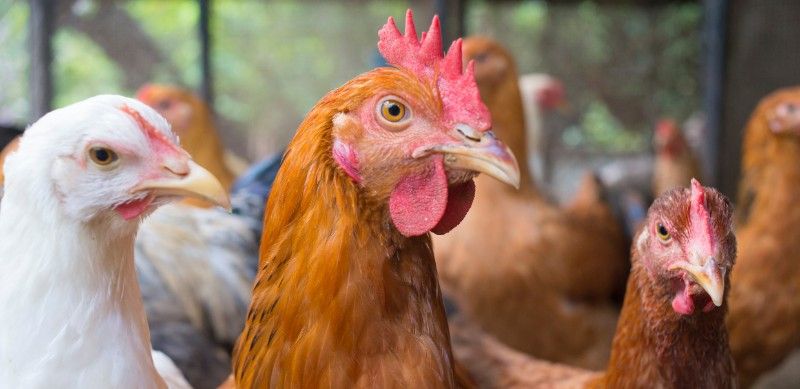Bird Flu Warning: It's Spreading, Mutating, and Infecting Mammals
Kevin Kavanagh, MD, examines the current bird flu outbreak and the possible dangers it holds for humans.
Avian flu has caused the culling of over 60 million birds.
(Adobe Stock)

As many of us remain focused on COVID-19 and its immunosuppressive augmentation of other infectious diseases, mother nature is not sitting still. I was again reminded of this fact when I attempted to purchase a dozen eggs for over $6. The average price in the United States was over $4 in December 2022. In January 2023, the New York Times reported a cost of over $7. This consumer price gouge is not the grocery store's fault, the COVID-19 bailout, or even our bloated federal deficit. It is the result of mother nature and the H5N1 bird flu pandemic.
Along with RSV, SARS-CoV-2, and Seasonal influenza, the bird flu is spreading rapidly in the United States at epidemic proportions. According to the New York Times, 60 million birds have been infected or killed (culled) in 47 states. So far, this has surpassed the second-largest outbreak in 2015, when 50.1 million birds died in 21 states. The number of states affected has more than doubled.
Bird flu has rarely affected humans; when it does, it is from directly handling birds. The virus rarely spreads from human to human. The concern is that when it infects humans, according to the Centers for Disease Control and Prevention (CDC), there is an approximately. From 2003 to 2006, H5N1 infected 232 people and killed 134.
But the one thing we have all learned from COVID-19 is that when RNA viruses spread rapidly, they mutate. This is what appears to have happened with H5N1. A new strain that is “highly pathogenic” has emerged and killed 1,600 snow geese in Colorado. To make matters worse, 3 Montana grizzly bears had to be euthanized after they caught the virus. This outbreak was described as the most significant foreign animal outbreak in US history and raises fears that the virus has mutated to promote the infection of mammals. A capability that could have profound consequences for the mammalian species, homo sapiens.
Unfortunately, this outbreak appears not to be a single occurrence. In Spain, a highly pathogenic H5N1 virus has infected the mink population. As of early October 2022, 52,000 minks were placed in cages, and the expected overall mortality of 0.2% to 0.4% rose to a mortality rate of 4%. Samples from the minks that died revealed the H5N1 virus. This virus was also found in 27 birds in the province and a neighboring province. The authors report that mink-to-mink transmission has occurred.
The virus which affected the mink population was a new strain, having the “uncommon mutation (T271A) in the PB2 gene.” Zhang Y et al (2012) have observed, “that amino acid 271A of PB2 plays a key role in virus acquisition of the mutation at position 226 of HA that confers human receptor recognition.” In other words, the strain which infected the mink population may be one step away from being able to spread in humans efficiently.
There have also been several gain-of-function laboratory experiments which, as dangerous as these experiments are, have shown the potential for the avian flu virus to take on characteristics of seasonal influenza. In 2006, CDC made 2 hybrid viruses (avian flu and human influenza) and infected ferrets, but the infection failed to spread. But research reported in 2010 by Dr. Yoshihiro Kawaoka from the University of Wisconsin produced a highly pathogenic hybrid with the pandemic ability of H1N1 (human influenza). The report states, “the new findings raise concerns that H5N1 and pandemic H1N1 viruses could reassort in individuals exposed to both viruses and generate an influenza strain that is both highly virulent and contagious.” The published research in the Proceedings of the National Academy of Sciences also stressed the importance of monitoring the emergence of avian flu viruses with mutations in the PB2 segment.
“…that the human virus PB2 segment functions in the background of an avian H5N1 virus, enhancing its virulence. Our findings highlight the importance of surveillance programs to monitor the emergence of human H5 reassortant viruses, especially those containing a PB2 segment of human origin.”
I’m starting to experience dé·jà Vu. Gain-of-Function experiments performed on a hazardous virus, viral spread from birds to mammals, spread between mammals, and mutations beginning to arise, which may be the first step in conferring the ability to transmit in humans.
I do not want to go through this again, especially since our current pandemic is not under control. We need to aggressively contain the spread of bird flu and increase our genomic surveillance for this disease. This is not a certainty since our current genomic surveillance for COVID-19 needs to be strengthened at a time when mutations are flourishing, and the dangers of long COVID are becoming more ominous.
Show, Tell, Teach: Elevating EVS Training Through Cognitive Science and Performance Coaching
April 25th 2025Training EVS workers for hygiene excellence demands more than manuals—it requires active engagement, motor skills coaching, and teach-back techniques to reduce HAIs and improve patient outcomes.
Phage Therapy’s Future: Tackling Antimicrobial Resistance With Precision Viruses
April 24th 2025Bacteriophage therapy presents a promising alternative to antibiotics, especially as antimicrobial resistance continues to increase. Dr. Ran Nir-Paz discusses its potential, challenges, and future applications in this technology.
Robust infectious disease surveillance, including rapid subtyping of influenza A, is essential for early detection, containment, and public health reporting of novel viral threats.